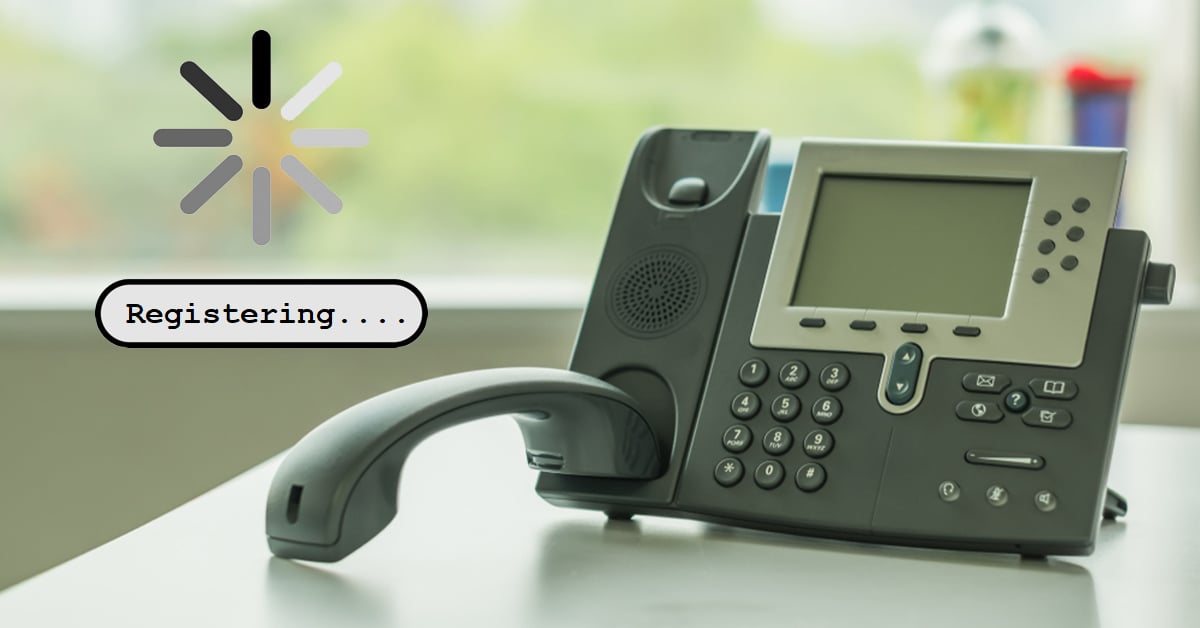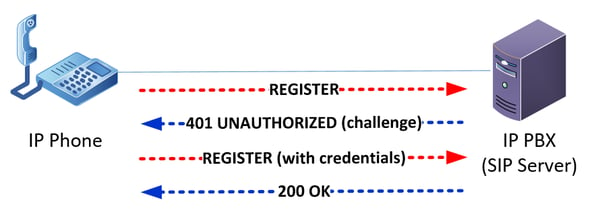How Voip Phones Register To A Gateway
If yous are a voice network engineer, then information technology has probably happened to you. Your SIP server is all gear up and yous accept plugged in your IP phone. Its lights come on, its screen is activated, you see the loading icon rotating, and then… nothing. For some reason, the phone will not register. IP phone registration issues are, unfortunately, not uncommon. In this article, nosotros examine the most common causes of registration failures, and best practices for troubleshooting and resolving them. To place the registration problems that can ascend, we must commencement understand how the registration of an IP telephone takes place using the SIP protocol. Although we are focusing on IP phones, the same can be applied to whatsoever SIP endpoint, including SIP clients (softphones), vocalism gateways, or teleconferencing systems. In order for a SIP IP phone to part, it must register to a SIP server, as well known every bit an IP PBX. A SIP account with a SIP URI (compatible resource identifier) and password must exist created inside the SIP server. Depending on the manufacturer of the SIP server, additional characteristics can be configured on each individual business relationship. The IP phone is provided with that SIP URI and countersign, equally well as the IP address of the SIP server. The phone then begins the registration process by sending a registration request to the SIP server. The commutation looks something like this: Once this sequence completes, the SIP server informs the IP phone of boosted settings, such equally the directory number, speed dials, and whatsoever other personalized configurations that accept been set upwardly. Keep in listen that registration enables a telephone to process phone call control data, i.eastward., the signaling necessary to allow for normal telephony operations. No commutation of voice packets has withal been initiated. Causes of IP telephone registration failure There are two primary categories of failures that tin touch IP phone registration. The first has to do with incorrect configuration of parameters on the SIP server and the IP phone. The second deals with problems on the network that may exist blocking SIP messages from reaching their intended destinations. Both of these aspects are farther described below. Incorrect configuration parameters Like any other service on a network, the registration of IP phones relies on the right configuration of both the server and the client. In a VoIP environment, this would be the SIP server and the IP phone, respectively. Both the SIP URI and the countersign must be entered correctly for the service to function. The SIP URI resembles an e-mail address and may look something like this: 2500@yoursipserver.net where 2500 may exist the phone number, and yoursipserver.internet is the address of the SIP server. Yous may too apply an IP address instead of a DNS name, or a label such equally the user's proper noun instead of the number. Each SIP server may take a unlike way of inbound the SIP URI when you configure it. Some permit the whole address to be input in a single field, while others require the number and the SIP server address to exist input separately in ii unlike fields. Verify with the manufacturer that you have entered the URI correctly in both the IP phone and the SIP server. Some additional configuration issues that are more often manufacturer-dependent are a misconfiguration of the particular phone model on the SIP server, the choice of the apply of TCP or UDP, and the choice of port number to exist used, which by default is 5060, or 5061 for secure SIP. Network bug affecting registration IP phone registration is a procedure requiring that the IP phone and the SIP server can communicate with each other over the network. If at that place is no network connectivity, registration will fail. If the SIP server and the IP telephone are on the same LAN, achieving connectivity is trivial. If both are connected to the same switch, for example, and their IP addresses are configured correctly, at that place is very little that can obstruct connectivity. However, nearly VoIP deployments involve either deject-based SIP servers, remote IP phones in multisite deployments, or VoIP endpoints used by teleworkers. This means that IP phones must communicate over a WAN or over the net to reach the SIP server. If your IP phones are located on a unlike site than your SIP server, then this introduces a multitude of network factors that can impact the SIP registration process. These include: Troubleshooting tips Keeping the higher up concepts in heed, when a phone fails to register, the following troubleshooting procedures should exist followed: Configuration parameters troubleshooting Network issues troubleshooting IP telephone registration problems can be frustrating at times, but if you lot have a plan for how to deal with them, you tin can speedily place the problem and resolve it in no time. Nosotros hope this article will become another useful tool in your VOIP troubleshooting toolkit. You lot may also similar: How to resolve one-way or no-fashion audio on VoIP calls How to troubleshoot VoIP problems caused by your firewall Equipping employees to utilize their enterprise IP phones at home
How does a SIP device register? 
Conclusion
Topics: SIP Phones, IP PBX, Business organisation Telephone System, SIP, Troubleshooting, Vocalism Protocols, firewall
How Voip Phones Register To A Gateway,
Source: https://info.teledynamics.com/blog/how-to-fix-ip-phone-registration-issues
Posted by: michelthres1987.blogspot.com


0 Response to "How Voip Phones Register To A Gateway"
Post a Comment